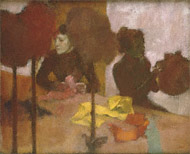Grades/Level: Lower Elementary (K–2), Upper Elementary (3–5)
Subjects: Visual Arts, English–Language Arts, History–Social Science
Time Required: 3–5–Part Lesson
Three to four class periods
Author: J. Paul Getty Museum Education Staff
Permissions: 
The lesson plan and downloadable materials on this page are licensed under a Creative Commons Attribution 4.0 International License. |
 |
|
 |
Students will be able to:
• compare and contrast the clothing, facial expressions, body language, setting, and color in two 19th-century paintings depicting women;
• write narratives about a woman in a painting;
• discuss the disparity between the wages of garment workers and the prices of the goods they make;
• create and decorate a paper hat. |
 |
 |
 |
Download the complete lesson by clicking on the "download this lesson" icon above.
Additional Resource:
Learn more about and compare two 19th-century paintings portraying women: Portrait of the Marquise de Miramon, née, Thérèse Feuillant by Jacques Joseph Tissot and The Milliners by Edgar Germain Hilaire Degas.
Glossary Terms:
Words in bold on these pages and in the lesson are defined in the glossary for this curriculum (see "For the Classroom" links above).
|
 |
 |
 |
| The Milliners, Edgar Germain Hilaire Degas, about 1882–before 1905 |
 |
|
 |
Common Core Standards for English Language Arts
Grades K–5
SPEAKING AND LISTENING
K.1 Participate in collaborative conversations with diverse partners about kindergarten topics and text with peers and adults in small and larger groups.
K.4 Describe familiar people places, things, and events, with prompting and support, provide additional detail.
1.1 Participate in collaborative conversations with diverse partners about grade 1 topics and text with peers and adults in small and larger groups.
1.6 Produce complete sentences when appropriate to task and situation. (See grade 1 Language standards 1 and 3 for specific expectations.)
2.3 Ask and answer questions about what a speaker says in order to clarify comprehension, gather information, or deepen understanding of a topic or issue.
2.4 Tell a story or recount an experience with appropriate facts and relevant, descriptive details, speaking audible in coherent sentences.
3.1 Engage effectively in a range of collaborative discussions (one-on-one, in groups, and teacher-led) with diverse partners on grade 3 topics and texts, building on others' ideas and expressing their own clearly.
4.1 Engage effectively in a range of collaborative discussions (one-on-one, in groups, and teacher-led) with diverse partners on grade 4 topics and texts, building on others' ideas and expressing their own clearly.
4.6 Differentiate between contexts that call for formal English (e.g., presenting ideas) and situations where informal discourse is appropriate (e.g., small-group discussion); use formal English when appropriate to task and situation. (See grade 4 Language standards 1 and 3 for specific expectations.)
5.1 Engage effectively in a range of collaborative discussions (one-on-one, in groups, and teacher-led) with diverse partners on grade 5 topics and texts, building on others' ideas and expressing their own clearly.
5.3 Summarize the points a speaker or media source makes and explain how each claim is supported by reasons and evidence, and identify and analyze any logical fallacies.
For more national and California state standards for this curriculum, refer to the charts found in the links at the top right of this page.
|
 |

|
 |




